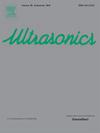Visualization of specular reflections with phase coherence imaging using sub-apertures
IF 3.8
2区 物理与天体物理
Q1 ACOUSTICS
引用次数: 0
Abstract
In recent years, phased array ultrasonic testing (PAUT) has gradually been substituted by approaches such as the Total Focusing Method (TFM), which use the Full Matrix Capture (FMC) acquisition scheme. Phase Coherence Imaging (PCI) has been proposed to mitigate the problems associated with amplitude-based TFM. PCI also holds high potential for dramatically simpler and far more affordable instruments as it only requires the phase of signals. However, in the context of PCI and in a scenario where the amplitude is not acquired, point-like scatterers would easily be identified due to their diffractive nature, while specular reflectors would not be detectable, as specular information is only captured by a specific group of elements known as sub-apertures (SA). In this paper, specular wave paths are analyzed to predict and choose the suitable emitting and receiving SA that are sensitive to specular reflections. The work demonstrates the effectiveness of the proposed method for revealing specular information by comparing PCI images of notches with the corresponding pairs of side-drilled holes (SDH) at their extremities. Results on two fatigue cracks are also presented as more realistic scenarios, and show that, while PCI highlights diffuse reflections, selecting the right SA on PCI mainly exhibit specular reflections, and reduce the image quality owing to the fact that the number of active elements in the aperture is reduced. When dedicated PCI instruments are present, the proposed method should be included in the inspection workflow to obtain images. PCI may not only be a complementary solution to amplitude imaging, but indeed, a solution in its own right. Finally, as Vector Coherence Factor (VCF) imaging can be achieved using binary acquisitions, this method allows to obtain images very similar to those from TFM should one wish to use simplified instruments.
利用子孔径进行相位相干成像的镜面反射可视化
近年来,相控阵超声检测逐渐被采用全矩阵捕获(FMC)采集方案的全聚焦法(TFM)等方法所取代。相位相干成像(PCI)已经被提出来缓解与基于幅度的TFM相关的问题。由于PCI只需要信号的相位,因此它也具有非常简单和更实惠的仪器的巨大潜力。然而,在PCI的背景下,在没有获得振幅的情况下,由于其衍射性质,点状散射体很容易被识别,而镜面反射器则无法被检测到,因为镜面信息仅由一组称为子孔径(SA)的特定元素捕获。本文通过分析反射波路径,预测和选择对反射敏感的发射和接收能谱。通过将缺口的PCI图像与缺口末端相应的侧钻孔(SDH)对进行比较,证明了所提出的方法在揭示镜面信息方面的有效性。两种疲劳裂纹情况下的结果也更为真实,表明PCI突出了漫反射,而在PCI上选择合适的SA主要表现为镜面反射,并且由于减少了孔径内有效元件的数量而降低了图像质量。当有专用PCI仪器时,建议的方法应包括在检查工作流程中以获得图像。PCI可能不仅是幅度成像的补充解决方案,而且确实是一种独立的解决方案。最后,由于矢量相干系数(VCF)成像可以通过二进制采集来实现,如果希望使用简化的仪器,这种方法可以获得与TFM非常相似的图像。
本文章由计算机程序翻译,如有差异,请以英文原文为准。
求助全文
约1分钟内获得全文
求助全文
来源期刊

Ultrasonics
医学-核医学
CiteScore
7.60
自引率
19.00%
发文量
186
审稿时长
3.9 months
期刊介绍:
Ultrasonics is the only internationally established journal which covers the entire field of ultrasound research and technology and all its many applications. Ultrasonics contains a variety of sections to keep readers fully informed and up-to-date on the whole spectrum of research and development throughout the world. Ultrasonics publishes papers of exceptional quality and of relevance to both academia and industry. Manuscripts in which ultrasonics is a central issue and not simply an incidental tool or minor issue, are welcomed.
As well as top quality original research papers and review articles by world renowned experts, Ultrasonics also regularly features short communications, a calendar of forthcoming events and special issues dedicated to topical subjects.
 求助内容:
求助内容: 应助结果提醒方式:
应助结果提醒方式:


